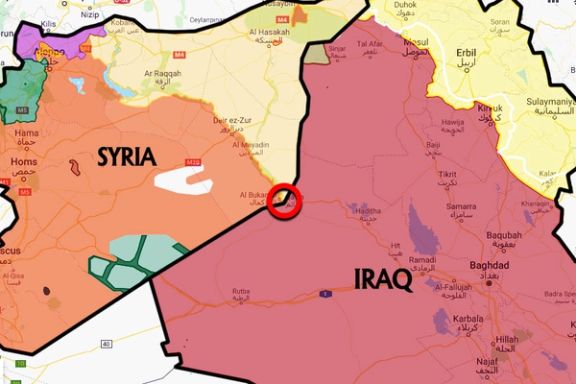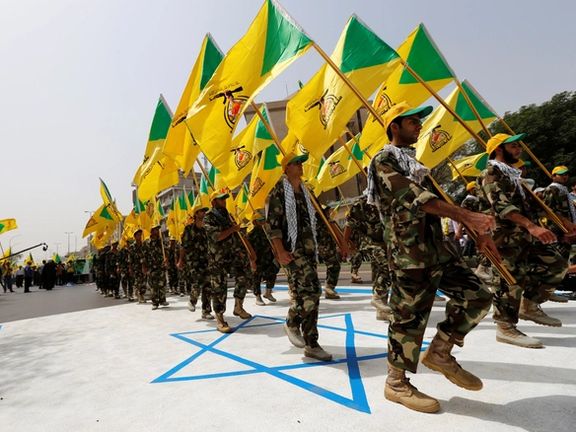Iran’s Covert War: How Iraqi Shia Militants Work With the IRGC

This month, three Iraqi Shiite militant groups, backed by the IRGC, announced their readiness to send forces to Lebanon to participate in a potential war between Hezbollah and Israel.

This month, three Iraqi Shiite militant groups, backed by the IRGC, announced their readiness to send forces to Lebanon to participate in a potential war between Hezbollah and Israel.
At the same time, the commander of the Ground Forces of the Islamic Republic of Iran has stated that groups known as the Resistance Front will not remain silent in the face of a possible war.
With that, all signs point to Tehran sending the necessary resources to Lebanon through these Iraqi militant groups, using Syria as a land bridge.
The Iraqi Resistance Coordination Committee (IRCC), also known as the Tansiqiya, is a coalition of Iranian-backed Iraqi militias – part of Tehran’s broader strategy to exert influence in the region, countering US and allied presence.
Among these groups are Harakat al-Nujaba (HaN), Kata'ib Hezbollah (KH), and Kata'ib Sayyid al-Shuhada (KSS).
But how do these Iran-backed groups operate, and how has Iran strategically positioned them to challenge Israel's security?

Harakat Al-Nujaba: A Strategic and Integral Arm of IRGC's extraterritorial unit, the Quds Force
Harakat al-Nujaba (HaN) is currently the most prominent group within the Iraqi Resistance Coordination Committee (IRCC).
According to a source close to Hashd al-Shaabi, an umbrella organization composed of various Shia militias in Iraq, the group was formed under the direct supervision of Qasem Soleimani, the former commander of the Quds Force of Iran's Islamic Revolutionary Guard Corps (IRGC).
HaN initially began as part of Asaib Ahl al-Haq (AAH) in 2004 but became an independent organization in 2013 due to disagreements between Akram al-Kaabi, the leader of HaN, and Qais al-Khazali, the leader of AAH. Despite their split, both groups maintain good relations and continue to cooperate because of their shared goals.
The group's initial budget of $10 million was provided by Lebanon’s Hezbollah, which also helped organize the group.
Soleimani reportedly preferred HaN to remain focused on military activities, rather than shifting towards political engagement.
Financially supported by the IRGC, HaN pays its fighters significantly more than other groups, with salaries around $1,400 per month – while other Iraqi fighters received a monthly salary of $300 to $400. The extensive financial backing has helped HaN increase its manpower with the group boasting over 10,000 members.
HaN is deeply integrated with the IRGC, essentially operating as an extension of the Quds Force rather than just a proxy group.
Notably, it played a significant role in the Syrian civil war, particularly in the battle of Aleppo.
The group appears to also enjoy a special relationship with Iran's Supreme Leader Ali Khamenei, facilitated by Mohsen Qomi, the deputy international affairs officer in Khamenei's office, who acts as their primary liaison
The group’s media operations are supported by the Union of Islamic Radio and Television, boasting an extensive organizational presence in Iran. The Persian section of HaN's website and social media accounts is notably more active and better maintained compared to its Arabic section. HaN operates 12 offices across major Iranian cities, including Tehran, Qom, and Mashhad, with a significant facility being an eight-story building located in Jannatabad, Tehran.

HaN forces receive their training at specific military facilities in Iran. These include the Pazooki Barracks in Tehran and the Imam Sadiq Brigade 83 base in Qom. These locations are significant training centers where HaN fighters are prepared under the supervision of the IRGC, enhancing their military capabilities and integration with Iranian strategic operations
HaN’s military activities are carried out under the IRGC's supervision, and IRGC special forces oversee the launching of its rockets at their targets. Hamid Fazeli, former head of Iran's Space Organization and head of Unit 340 of the IRGC's Quds Force, directs the oversight operations.
A source close to Hashd al-Shaabi shared with Iran International that the Quds Force has established a weapons manufacturing factory for HaN in Iraq, and a significant portion of these weapons are sent to Lebanon. These are the shipments that Israel frequently tries to interdict as the enter Syria and transports west towards Lebanon.
Akram al-Kaabi, the Secretary-General of HaN, has reportedly lived in Iran for a long time and travels to Iraq using a Misaq card and an Iranian passport. The Misaq card, issued to prominent figures of the Resistance Front, facilitates smooth passage through airports and highways.
According to the same source, the 47-year-old has three wives and nine children who live in two of his homes in Jannatabad and the Olympic Village area of Tehran.
He is known to frequent Iran's political circles and has met with numerous key figures, ranging from former President Ebrahim Raisi to Ahmad Alamolhoda, the Friday prayer leader of Mashhad, and Mohsen Rezaei, the Secretary of the Supreme Economic Coordination Council.
Today, the group comprises four factions. Qasim al-Jabbarin conducts attacks on Erbil Airport, while Saraya Ababil specializes in drone operations. As'hab al-Kahf, established by Hezbollah's Imad Mughniyeh, focuses on IED attacks against American forces. Saraya Awliya al-Dam targets US bases in the Persian Gulf and supports Houthi forces in Yemen.
Seven years ago, HaN announced the formation of the Golan Liberation Corps, claiming readiness to retake the Golan Heights from Israel at Syria's request.
After Hamas' attack on Israel on October 7 last year and the start of the Gaza war, Harakat al-Nujaba attempted to attack Israeli territory. Last November, the group claimed a missile attack on Eilat Port in Israel.
According to a source close to the IRGC, the organization has also established an economic commission for HaN. This commission operates offices in China and the United Arab Emirates and handles the sale of oil on behalf of the IRGC. This arrangement enables the IRGC to carry out certain financial transactions through HaN, effectively bypassing official records and maintaining a level of financial opacity.
The source also mentioned that HaN returns the proceeds from oil sales to the Quds Force because the IRGC covers all of its expenses, further highlighting the deep integration and dependency of the group on the IRGC.
Kata’ib Hezbollah: From the Badr Corps to Iran’s anti-Israel proxy
The second group declaring readiness for war with Israel is Kata'ib Hezbollah (KH). This powerful Iraqi militant group was founded by Abu Mahdi al-Muhandis in 2003.
Initially, the group focused on combating US forces in Iraq, but it later joined the Syrian civil war, fighting in support of Bashar al-Assad.
The US designated KH as a terrorist group in 2009.
According to the source close to Hashd al-Shaabi, KH traces its roots back to the Badr Corps, a Shiite militia and political party in Iraq whose fighters allied with Iran during the Iran-Iraq War.
Abu Mahdi al-Muhandis established KH by leveraging familial connections within the Badr Corps, eliminating the need for structural support from Hezbollah Lebanon.
This was the first group of militia that Tehran would send to Syria to help Assad suppress street protests.
Abu Mahdi al-Muhandis, the founder of the group, was killed in Iraq alongside Soleimani in a US airstrike on January 3, 2020. He was succeeded by Ahmed al-Hamidawi.
While the Islamic Republic financially supports KH, the group also engages in extensive economic activities.
According to an Iraqi source, they purchase land in Europe, sell oil, and have acquired shares in several Iranian refineries. Additionally, the group earns approximately $100 million from exporting chemical fertilizers from Iran to Iraq.
Last February, a US drone strike killed one of the group's prominent leaders, Abu Baqir al-Saadi. Following this, the group's leader, Ahmed al-Hamidawi, along with his three brothers, As'ad, Arqad, and Akhlad, fled to Iran, where they now reportedly reside.
It was previously disclosed that Abu Mahdi al-Muhandis lived with his Iranian wife on Golestan 1st Street in Tehran's affluent Pasdaran neighborhood, known for its upscale residences, commercial centers, and proximity to political and military elites.
Since the start of Israel’s war on Hamas on October 7 last year, KH has claimed responsibility for conducting more than 150 attacks against US forces.
Kata'ib Sayyid al-Shuhada: Soleimani’s strategic contractors in Syria
Kata'ib Sayyid al-Shuhada (KSS) is the smallest of the three groups that have declared readiness to send forces to Lebanon.
This group announced its existence in 2013 when three of its members were killed in the suburbs of Damascus.
KSS has primarily been active in Syria, claiming to have sent 500 fighters to Damascus and Eastern Ghouta.
According to the source close to Hashd al-Shaabi, they cooperated with Soleimani in Syria as contractors, reportedly receiving $2 million for maintaining a front and advancing five kilometers.
Recently, KSS has sought to attract more attention by attacking American targets.
The group’s leader, Abu Alaa al-Walai, welcomed Ebrahim Raisi's selection as Iran’s President in 2021, stating that his "victory" would bolster IRGC-supported militant groups.
KSS has about 3,000 fighters and receives funding from the IRGC's Quds Force, though it also receives payments from the Iraqi government as part of the Hashd al-Shaabi.
The group maintains close ties with Lebanon’s Hezbollah, benefiting from financial and intelligence support.
Last year, the US designated KSS as a terrorist organization.